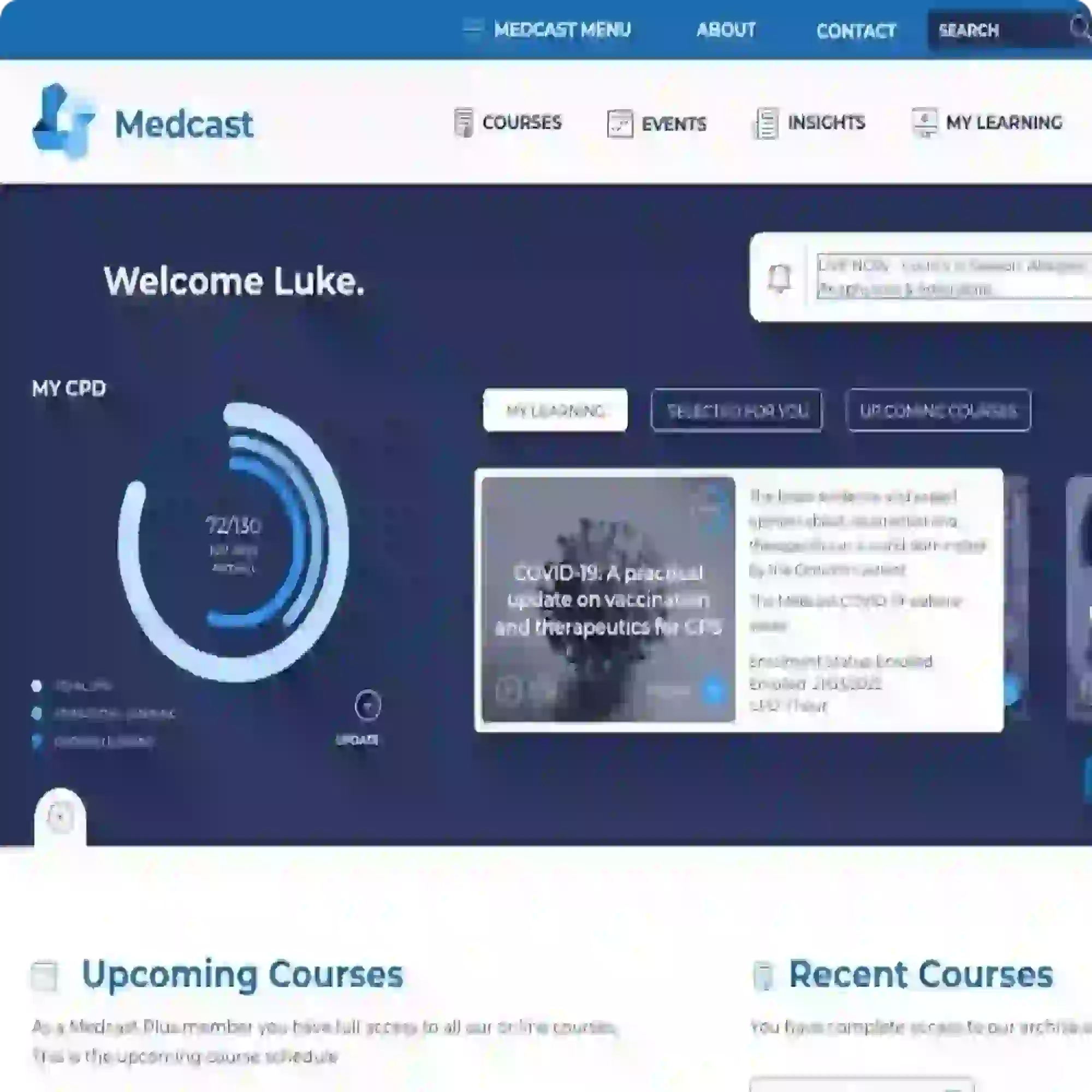Metabolic dysfunction-associated fatty liver disease - clinical fact sheet and MCQ
![]()
Overview
Metabolic dysfunction-associated fatty liver disease (MAFLD) is a prevalent and progressive liver condition, affecting 25–30% of adults globally. It is now the preferred term over non-alcoholic fatty liver disease (NAFLD), recognising hepatic steatosis as part of a broader metabolic syndrome rather than excluding other causes of liver injury.
MAFLD is diagnosed by evidence of hepatic steatosis in conjunction with metabolic risk factors. It should be assessed in adults with type 2 diabetes, obesity or two or more metabolic risk factors (including hypertension, dyslipidaemia and prediabetes). This new definition allows for other coexisting causes of liver disease (including alcohol-related liver disease), which was not possible with the prior exclusionary definition of NAFLD.
This change helps in recognising the common clinical presentation in primary care of multiple aetiologies of liver disease (including hepatitis B and C) in the one individual.
MAFLD is associated with obesity, type 2 diabetes mellitus (T2DM), dyslipidaemia, hypertension, and insulin resistance. It can progress to steatohepatitis, fibrosis, cirrhosis, and hepatocellular carcinoma (HCC). Cardiovascular disease (CVD) is the leading cause of death in people with MAFLD. Early identification and holistic risk factor management are essential to reduce morbidity and mortality.
Diagnosis of MAFLD
Diagnosis of metabolic dysfunction-associated fatty liver disease is based on the detection of hepatic steatosis (via imaging, biomarkers, or liver histology) and the presence of one of the following:
-
T2DM
-
evidence of metabolic dysregulation (eg elevated waist circumference, blood pressure, triglycerides, or insulin resistance)
1. Differential diagnoses for MAFLD include:
-
alcohol-related liver disease (history of significant alcohol intake essential for differentiation)
-
viral hepatitis (positive serology; often younger, with fluctuating transaminases)
-
autoimmune liver disease (positive autoantibodies; elevated IgG, affects younger women)
-
drug-induced liver injury (temporal link to new medications or supplements)
-
hereditary liver conditions (eg Wilson's disease, haemochromatosis)
These conditions can co-exist with MAFLD and should not preclude the diagnosis.
2. Red flags for urgent referral include:
-
hepatic decompensation (ascites, jaundice, encephalopathy)
-
suspected hepatocellular carcinoma (new focal liver lesion)
-
rapid rise in liver enzymes or bilirubin
-
symptoms suggesting other liver disease aetiologies such as pruritus, fatigue, abdominal pain (eg autoimmune hepatitis, haemochromatosis)
3. Risk factors for disease progression:
-
advanced age
-
T2DM
-
obesity (particularly visceral adiposity)
-
sedentary lifestyle
-
smoking
-
sleep apnoea
-
genetic predisposition (eg PNPLA3 variants)
Assessments and tests in primary care
Who to assess for MAFLD:
1. adults with obesity and/or type 2 diabetes mellitus
2. those with two or more metabolic risk factors (listed above) regardless of body weight
(image credit: GESA 2024) Assessment algorithm for a patient presenting with MAFLD
Non-invasive tests for liver fibrosis are complementary and include:
1. Clinical assessment and blood tests:
-
weight, BMI, and waist circumference
-
fasting glucose or HbA1c, lipid profile
-
FBC; liver function tests (LFTs): ALT and AST may be normal even in advanced disease
-
if MAFLD with raised aminotransferases, test for viral hepatitis, autoimmune liver disease, haemochromatosis, and Wilson’s disease
-
Fibrosis risk stratification: use the FIB-4 index (age, AST, ALT, platelet count)
-
easily calculated and cost-effective
-
should not be used in:
-
those <35 years old
-
the presence of thrombocytopaenia from non-hepatic causes
-
the presence of acute hepatitis
-
use an upper cut-off of 2.0 for patients > 65 years
If FIB-4 is indeterminate or high: use transient elastography (FibroScan) or refer for specialist assessment.
2. Fibrosis assessment using FibroScan:
this is the most critical prognostic factor in MAFLD and assesses physical properties of the liver, eg stiffness
-
becomes less accurate with increasing BMI
3. Imaging - ultrasound or CT:
first-line tool to detect hepatic steatosis if high risk of MAFLD
-
sensitivity reduced in people with BMI >40 or if low degree of hepatic steatosis
-
used to assess the anatomy of the liver and features of portal hypertension
Management of MAFLD
People with MAFLD and clinical, laboratory or imaging evidence of cirrhosis should be referred to a clinician with expertise in liver disease.
1. Lifestyle intervention is the first-line treatment in metabolic dysfunction-associated fatty liver disease:
-
weight loss: target ≥5% for steatosis, ≥7% for inflammation, ≥10% for fibrosis improvement
-
diet: Mediterranean-style diet recommended; avoid processed foods and sugar-sweetened beverages
-
physical activity: at least 150 minutes/week of moderate-intensity exercise; resistance training also beneficial
2. Pharmacotherapy:
Currently, no medications are specifically approved for MAFLD in Australia. Treat comorbidities such as T2DM, obesity, and dyslipidaemia aggressively.
-
Pioglitazone: may be used in selected patients with biopsy-proven steatohepatitis
-
GLP-1 receptor agonists (eg semaglutide): show promising liver benefits in people with T2DM and obesity
-
Vitamin E: may be considered in non-diabetic adults with biopsy-proven steatohepatitis but long-term safety is uncertain
3. When to refer to a specialist:
-
indeterminate or high fibrosis risk on FIB-4 or other non-invasive tests
-
suspicion of advanced fibrosis or cirrhosis
-
diagnostic uncertainty or suspected co-existing liver diseases
-
consideration of emerging therapies or clinical trial enrolment
4. Follow-up:
-
People with MAFLD who have an initial FIB-4 result showing a low risk of advanced fibrosis are recommended to undergo repeat noninvasive fibrosis testing in 3 years
-
monitor cardiovascular risk factors, glycaemic control, liver enzymes, and lifestyle progress at regular intervals
-
people with advanced fibrosis or cirrhosis require HCC surveillance and more intensive monitoring
References
- MAFLD Consensus Statement Working Group. Recommendations for the assessment of metabolic dysfunction-associated fatty liver disease (MAFLD) in primary care: a consensus statement. Melbourne: Gastroenterological Society of Australia, 2024. (last accessed May 2025).
- EASL–EASD–EASO Clinical Practice Guidelines on the management of metabolic dysfunction-associated steatotic liver disease (MASLD)
Tacke, Frank et al.Journal of Hepatology.2024;81(3):492 - 542. - Long MT, Noureddin M, Lim JK. AGA Clinical Practice Update: Diagnosis and Management of Nonalcoholic Fatty Liver Disease in Lean Individuals: Expert Review. Gastroenterology. 2022;163(3):764-774.e1.
Claim your CPD
After reading the clinical summary above and reviewing the references, complete the quiz to gain 30 minutes of EA CPD and 30 minutes of RP CPD.
You can either self-report CPD to your CPD home, or Medcast will track your learning via your personal CPD Tracker and you can download and report these points once a year. See our CPD Tracker FAQ.
Quiz
Please log in or sign up for a free Medcast account to access the case study questions and achieve the CPD credits.
The Medcast medical education team is a group of highly experienced, practicing GPs, health professionals and medical writers.
Become a member and get unlimited access to 100s of hours of premium education.
Learn moreCo-billing and split billing are often a source of confusion for many GPs. This FastTrack clearly defines these two methods of billing, including examples, explanations of when it is and isn’t appropriate to co- or split bill, and common compliance pitfalls. 30 mins each RP and EA available with the quiz.
The Coordinated Veterans’ Care (CVC) Program is a DVA initiative that allows GPs to provide structured, proactive care in the community for eligible veterans and war widows. This FastTrack provides a guide to billing the CVC program, and outlines a strategy for its practice-wide integration.
Achilles tendinopathy is a common cause of posterior heel pain and functional impairment. GPs are well-placed to coordinate care for these patients. This FastTrack fact sheet provides a concise summary of diagnosis and non-surgical management, including when to refer. Earn 30mins each RP and EA CPD with the quiz.

